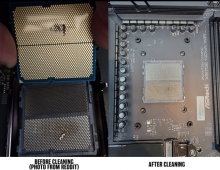
AMD Officially Unveils Polaris GPU Architecture at CES
Confirming previous rumors, AMD on Monday unveiled its the 'Polaris' graphics architecture, which brings new fourth-gen GCN cores, a new memory controller, new multimedia cores, and a new geometry processor. Polaris will be at the heart of their 2016 GPUs, and is designed for what can now be called the current-generation FinFET processes.
AMD on mOnday demonstrated a Polaris based card in action. The company showed off a PC with an early Polaris GPU running Star Wars Battlefield at 1920x1080 resolution at 60 fps and consuming just 86 watts. The exact same system outfitted with a GeForce GTX 950 consumed 140 watts. AMD used desktop parts to sub in for laptop parts as it didn’t have mobile components yet, but the chip will initially be aimed at laptops and more entry-level desktop graphics cards.
The purpose of this demonstration was to showcase that a Polaris GPU was up and running, that the small Polaris GPU in question could offer performance comparable to an Nvidia GTX 950, and finally to show off the energy efficiency advantage of the small Polaris GPU over current 28nm GPUs.

Polaris chips will support both HDMI 2.0a and DisplayPort 1.3. The new chips are also capable of encoding and decoding H.265 video up to 4K resolution. That’s it for details on the new GCN, other than high-level bullet points like "improved shader efficiency," "memory compression," "better instruction pre-fetch," and such.
Polaris chips won’t leverage AMD’s involvement with High Bandwidth Memory, at lest for the most models. Instead relying on the more common GDDR5, or a variant of it called GDDR5+. AMD officials said that decision was based on the power and cost issues associated with HBM for a mobile part today, but reiterated that they believe in HBM and will continue to use it and future iterations of it.

Polaris, at least the initial ones, will be aimed at laptops and low-power consumption tasks. AMD said it should enable performance-levels in thin-and-light laptops that have been unheard of before.
AMD, as well as rival nvidia, have both been stuck on 4-year-old 28nm process, but this year AMD will move to either Global Foundries’ 14nm or TSMC’s 16nm process. Both feature FinFETs, which allow for better control of power leakage while offering more performance.





















